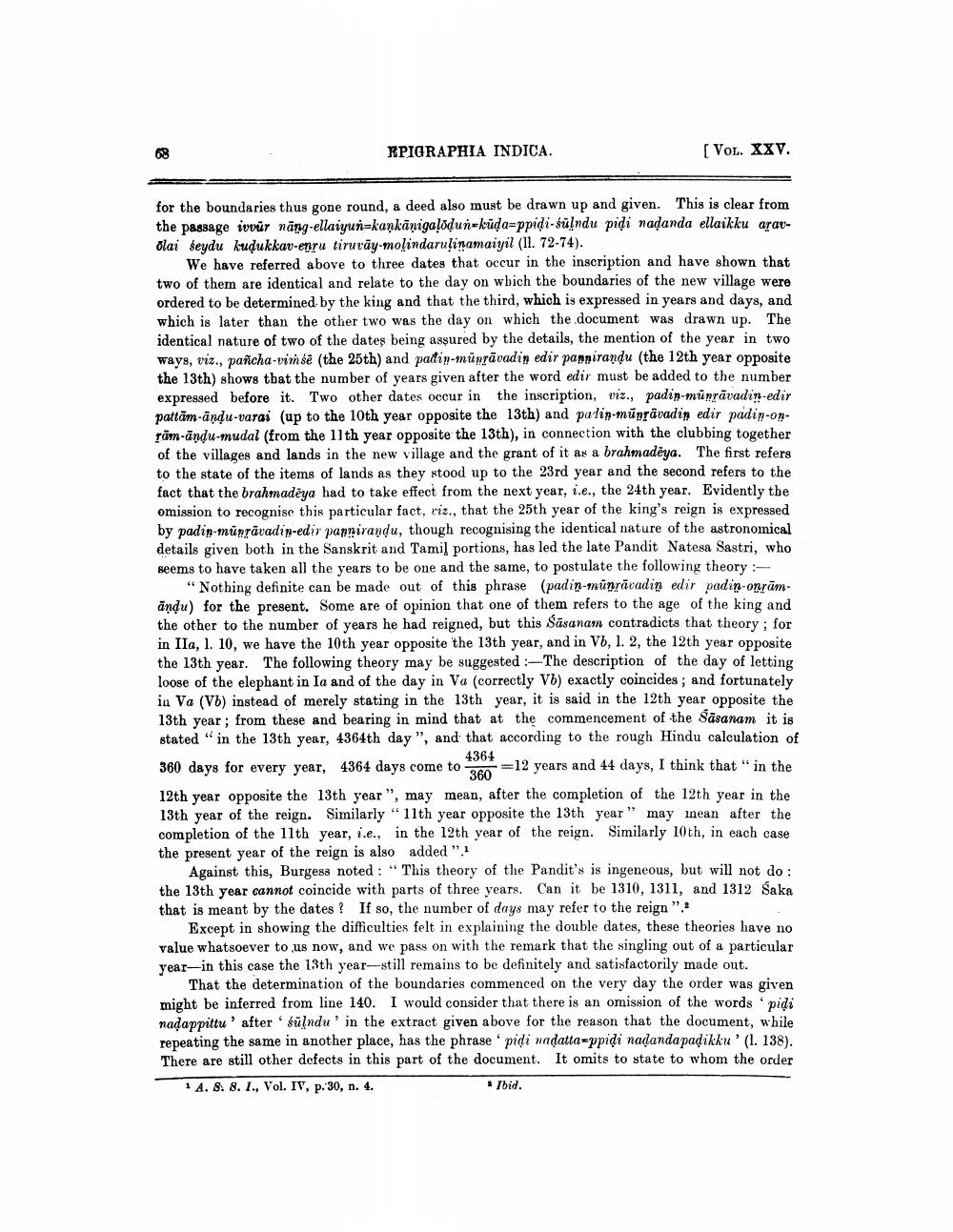________________
RPIGRAPHIA INDICA.
[Vol. XXV.
for the boundaries thus gone round, a deed also must be drawn up and given. This is clear from the passage ivvür nāng-ellaiyun=kaņkānigaļodun=kuda=ppidi-sülndu pidi nadanda ellaikku aratOlai seydu kudukkav-enru tirurāy-molindarulinamaiyil (11. 72-74).
We have referred above to three dates that occur in the inscription and have shown that two of them are identical and relate to the day on wbich the boundaries of the new village were ordered to be determined by the king and that the third, which is expressed in years and days, and which is later than the other two was the day on which the document was drawn up. The identical nature of two of the dates being assured by the details, the mention of the year in two ways, viz., pañcha-vimse (the 25th) and patin-mūnrāvadin edir pannirandu (the 12th year opposite the 13th) shows that the number of years given after the word edir must be added to the number expressed before it. Two other dates occur in the inscription, viz., padin-mũnrāvadin-edir pattām-andu-varai (up to the 10th year opposite the 13th) and palin-mūnrāvadin edir padin-onrām-andu-mudal (from the 11th year opposite the 13th), in connection with the clubbing together of the villages and lands in the new village and the grant of it as a brahmadēya. The first refers to the state of the items of lands as they stood up to the 23rd year and the second refers to the fact that the brahmadėya had to take effect from the next year, i.e., the 24th year. Evidently the omission to recognise this particular fact, riz., that the 25th year of the king's reign is expressed by padin-munrāvadin-edir pamirandu, though recognising the identical nature of the astronomical details given both in the Sanskrit and Tamil portions, has led the late Pandit Natesa Sastri, who seems to have taken all the years to be one and the same, to postulate the following theory -
"Nothing definite can be made out of this phrase (padin-munracadin edir padin-onrāmandu) for the present. Some are of opinion that one of them refers to the age of the king and the other to the number of years he had reigned, but this Sāsanam contradicts that theory; for in IIa, 1. 10, we have the 10th year opposite the 13th year, and in Vb, l. 2, the 12th year opposite the 13th year. The following theory may be suggested :-The description of the day of letting loose of the elephant in Ia and of the day in Va (correctly Vb) exactly coincides; and fortunately in Va (Vb) instead of merely stating in the 13th year, it is said in the 12th year opposite the 13th year; from these and bearing in mind that at the commencement of the Sasanam it is stated in the 13th year, 4364th day", and that according to the rough Hindu calculation of
43641 360 days for every year, 4364 days come to an 12 years and 44 days, I think that " in the 12th year opposite the 13th year", may mean, after the completion of the 12th year in the 13th year of the reign. Similarly "11th year opposite the 13th year" may inean after the completion of the 11th year, i.e., in the 12th year of the reign. Similarly 10th, in each case the present year of the reign is also added ".1
Against this, Burgess noted : " This theory of the Pandit's is ingeneous, but will not do: the 13th year cannot coincide with parts of three years. Can it be 1310, 1311, and 1312 Saka that is meant by the dates? If so, the number of days may refer to the reign",
Except in showing the difficulties felt in explaining the double dates, these theories have no value whatsoever to us now, and we pass on with the remark that the singling out of a particular year-in this case the 13th year---still remains to be definitely and satisfactorily made out.
That the determination of the boundaries commenced on the very day the order was given might be inferred from line 140. I would consider that there is an omission of the words pidi nadappittu' after füļndu' in the extract given above for the reason that the document, while repeating the same in another place, has the phrase 'pidi wadattaeppidi nadanda padikku' (1. 138). There are still other defects in this part of the document. It omits to state to whom the order 14. 8. 8. I., Vol. IV, p. 30, n. 4.
* Ibid.




